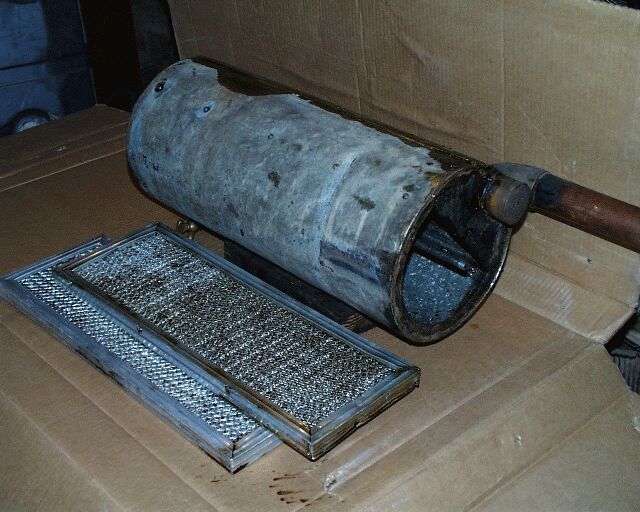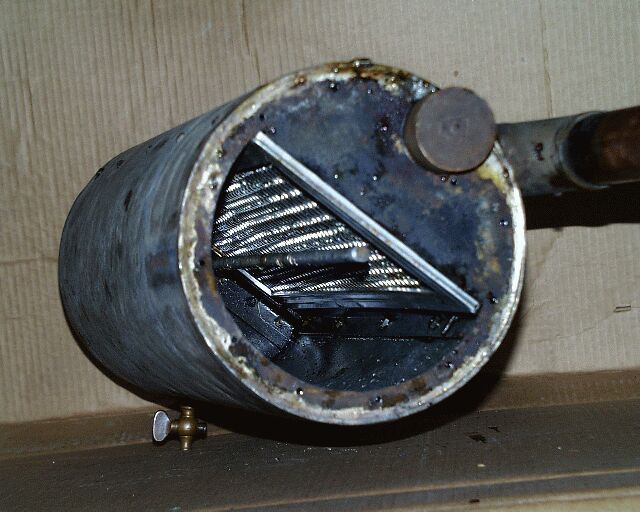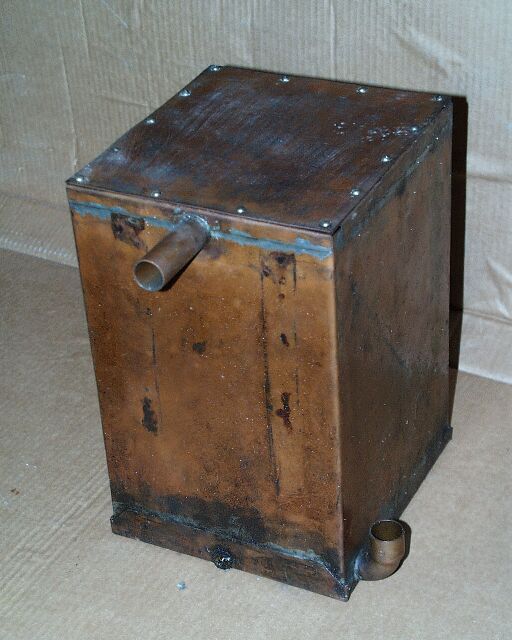
ON THE SEPARATION OF OIL FROM FEED WATER
In any condensing steam car using superheated steam, the problem of oil in the condensate is a serious issue. In flash boilers and welded water tube boilers oil will deposit on the surfaces where heat flow is highest, carbonize and cause the tube to overheat. Usually, carbonized oil can be removed only by sand blasting or burning out with oxygen. Thus, keeping the boiler clean becomes a major maintenance task. For boilers using expanded joints, the problem is much worse as the oil quickly penetrates the joint and causes it to leak. In my experience, once rolled joints start leaking from this cause, rerolling is a total waste of time and effort. The only cure is to remove the old tube bundle, carefully clean the holes in the tube sheets, and retube the boiler! The Stanley factory solution to this problem was to use steel tubes welded to the lower tube sheet. This meant retubing the boiler was essentially impossible and boiler life was limited to the time for the relat! ivel y thin tubes to rust through, a matter of three to five years, regardless of whether the car was driven!
In marine practice, the problem of oil in the feed was treated very seriously indeed. Most steam ships using reciprocating engines used saturated steam so the cylinders and valves were lubricated solely with water. Even so, some oil would enter the condenser and filters of various types were a normal part of the feed water system. The classic system divided the feed water tank into several compartments so the condensate flowed through three filter sections before entering the main tank. The filtering material was either loofa sponges or excelsior, in other words, shreds of cellulose fiber. While the filters could be cleaned by blowing steam through them, the fibers tended to disintegrate, and it was normal to replace the filter material every week. (On coal fired ships, used up filter material was burned in one of the boilers.) More recent ships using superheated steam, and, thus, needing oil in the cylinders, used diatomateous earth filters, replacing the material daily.
Separators to remove oil from exhaust steam were often used in power plants but seldom in ships as they had to be very large to be efficient. I know that John Goold of Camerton, England is offering one for use in condensing Stanley cars, and have seen examples fitted to several cars. It uses a proprietary filter from a commercial supplier and as a result is both heavy and expensive. It must be mounted in an upright position, which is not a major problem behind a V-nose condensor, but is difficult in a later flat condensor chassis. I have no direct knowledge of its effectiveness, but from some observations made during the recent steam car tour in Vermont, I would judge it to be no better than, and subject to the same limitations as, my home made filter described below.
About 1900 a Mr. W. J. Baker of London invented an exhaust steam oil separator using a series of baffles in a large chamber, which was able to remove more than 98% of the oil on a continuous basis. The significant word in the description is "large", the minimum recommended size was three times the volume of the low pressure cylinder! For a fast turning engine, like the Stanley, the ratio of volumes should be much larger. The idea is to preclude any drop of oil on the baffles being picked up by the steam passing through them by keeping the steam velocity low. I built a filter based on the Baker design some years ago, using expanded aluminum mesh air filter elements two inches thick in a "muffler" seven times the volume of the engine. With certain limitations, the filter has worked well. It will only remove liquid droplets, any oil vaporized in its passage through the engine will pass the filter and condense, with the steam, in the condensor. Therefore, it should be connected! between the feed water heater and the condensor so as to work on "cool" steam. As it removes all liquid droplets, it removes any water condensed in the feed water heater, a significant loss of condensate. This leads to an operational problem, it must have an open drain when ever it is in use. But, if the drain is left open while the car is parked, it leaves a puddle of nearly pure cylinder oil!
This filter is quite effective. The top end of my condensor is very clean, and the exit end of the steel filter housing is actually getting rusty. However, some oil is getting through, the resulting condensate is a translucent yellow. (The drainage from the filter looks like cafe au lait.) I have assumed this oil was vaporized by the steam and, thus, not separated.
My filter is eight inches in diameter by eighteen long and contains two aluminum filters six and one half by eighteen by one inch thick. The filters are mounted at an angle about 30 degrees from vertical, and the steam passes upwards through them. Vertical filter elements with sideways flow would duplicate the Baker configuration.
To remove the residual oil in the condensate, I built a filter tank on the lines of 1900 steam ship practice. I have found only one reference giving the recommended size of a filter tank, it should contain about three minutes of full power feed water flow. Accordingly, my tank holds three gallons, and is of such a size and shape as to fit just forward of the pump box on a condensing Stanley. Rather than absorbing the oil in cellulose fiber, the oil is adsorbed on the polypropylene fibers of densely packed plastic scrubbing pads. As the oil wets the plastic much more easily than the water, it collects on the fibers until it forms drops big enough to break free. These large drops will float to the top of the filter if the downward flow of the water is not too fast. This kind of filter works best if the elements are coated with the stuff one is trying to remove. In other words, the filter should not be too clean! Periodically removing the oil floating at the top of the tank is! the only servicing needed during the touring season. My tank is fitted with two drains, one at the bottom, used in draining the system at the beginning of winter, and another two inches below the normal water level. When blowing down the boiler, the upper drain is opened into a bucket. After a few minutes, when the water has stopped flowing, the bucket can be replaced by a tin can into which oil will drip for a day or more.
As the polypropylene will probably melt if exposed to much steam, it is necessary to separate any excess steam from the flow of water to the filter. For this reason I have made a centrifugal separator at the bottom of the condensor which allows any overflow steam to blow down on the road. The drain on this device is connected to the top of the filter tank with nominal 3/4 inch copper water pipe. Another bit of 3/4 copper connects the bottom of the filter to the top of the main water tank. Thus, the filter tank is kept full regardless of the level in the main water tank.
At this point it is necessary to say a few words about cylinder oils. Most steam cylinder oils are "compounded oil", that is, they are a mixture of mineral oil and an animal oil, usually beef tallow. The animal oil mixes freely with water and reduces the tendency of oil being washed out of the cylinder by wet steam. Unfortunately, the properties that are desirable in the cylinder make it very difficult to separate the oil from either the exhaust steam or the condensate. Even worse, the animal oil will decompose in the boiler into "fatty acids" which can cause serious corrosion problems. Therefore, I strongly urge any owner of a condensing steamer to avoid compounded oils like the plague. Use only a straight mineral cylinder oil, such as Cylesstic TK 1500 (Exxon) or Gargoyle Extra Hecla Mineral (Mobil). I have been using the Exxon product.
Using the above described separators and oil, the contents of my water tank after several hundred miles of steaming is slightly cloudy but colourless. When I drain the tank, there is a slight coloured sheen of oil floating on the last water to flow out, but no visible drops or globs of oil. I am sure there is oil in the water tank as I have made no serious attempt to clean it since I made the filter tank. However, I believe, in my case, the oil in condensate problem is finally under control, providing I can just remember to open the steam separator drain when driving and close it when parking!
REFERENCES AND NOTES
For a description of Baker separators see ASME Transactions vol. 24 (1903) 'Topical Diiscussions' #150 pp. 341-8, especially comments by Mr. F. Meriam Wheeler.
For sources of expanded aluminum mesh filters, contact any major supplier of air conditioning filters. They can make to your drawings at fairly low cost.
My "muffler" was made from a length of eight inch stove (flue) pipe and 1/8 inch plates for the ends with brazed joints. One end plate has a hole large enough to access the filters for cleaning and a series of tapped screw holes for fastening a cover. The filters are mounted on rails bent from sheet metal mounted in the "muffler", and kept in place by angles on the end plate and cover plate.
For a description of marine feed water filter tanks, see the "Handbook for the Care and Operation of Naval Machinery" by Lieut. H. C. Dinger, Van Nostrand Co., New York, (1908), chapter XIV, "Feed and Filter Tanks".
For my water filter tank I bought a case of #572 Plastic Scouring Pads from the Kellog Brush Manufacturing Co. of Easthampton, Mass. 01027. They expressed no surprise at a request for pads for filtering purposes, I was far from their first such customer! Unfortunately, they have stopped making the pads since I made my filter. All four dozen pads are packed into the three gallon tank. The tank being made of roofing copper with soldered seams, must be mounted on padded brackets to support its thirty pound full weight without any risk of chafing through the thin sides. I used one and a half inch wide steel straps covered with old belt leather.
Pictures

Disassembled exhaust steam filter. Note that one of the filters is much oilier than the other, this was the one facing the steam inlet.

View through the cleanout opening, showing filters in place. Note drain cock at bottom rear and steam outlet to upper right.

Prototype water filter tank. This one was not used on the car as I had made it the wrong size. Note water inlet at top center, outlet at bottom right and fitting for drain cock at bottom center.
David K. Nergaard (Revised 16 August 2000)
Back to Papers